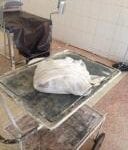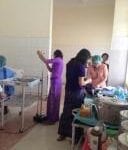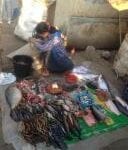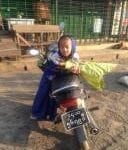April 22, 2014
Our team visited the town market in the morning, a colorful street market full of flowers and vegetables. Some of the vegetables and roots were too exotic for me to recognize. I remember walking with my housekeeper through similar markets in Vietnam as a little girl. My stomach was much stronger then, as I could sit down and have a bowl of noodles without having to worry about diarrhea later. Giardia are no longer my friends, as I have become a true westerner after several decades living in the U.S.. Now, I have to be careful about eating street food. I was advised by my infectious disease specialist friends and family members before I left to: only eat fruits that you can peel, brush your teeth with bottled water, and always, always have hand sanitizer in your backpack. I felt pretty much at ease though, as I had travelled to Vietnam, China, and Tanzania in 2005 without incident.
I followed Noel, a compassionate ICU nurse from Cleveland, to a stall with baskets full of bugs. They were cicadas, all dried up and dead, of course. Noel had such an adventuresome spirit. She was also a global traveller like me. This was her second medical mission. Her first was in Belize where she had to trek through the jungle to get to her clinics.
The vendor looked at us with curiosity. He reached for a cicada and showed us how to eat it. We were hesitant. He held up a can and told us how a can would cost us a dollar. A dollar a can? It must have been like eating caviar in Myanmar, as later I had a bowl of noodles in the night market for 20 cents! Noel was fascinated by the insects. We should try it, she told me.
I remember the night market in China two years ago when David and the tour guide were challenging me to eat a grilled silk worm larvae kabob. I had taken numerous photos of this stall where skewers were displayed of longhorn insects, centipedes, spiders and silkworm larvae. They even offered starfish! How do you eat a starfish? Obviously, you have to break the shell and eat whatever’s inside of the shell.
I bought a silk worm larvae skewer for two dollars. After eating about three of the larvae, I proclaimed that they tasted like “walnuts” and I offered the rest to David and the tour guide.
“I am not hungry, thank you.” The tour guide told me politely and looked amused.
“No thank you, sweetie, I am fine.” David said flatly.
“I am FINE? What a coward!” I was mumbling to myself as I tossed the rest of skewer into the trashcan nearby. They did taste like salty walnuts; they just looked different. Had I been blind folded, I could have eaten the rest. I am glad I tried the grilled larvae anyway. Until you try something new, how do you know you won’t like it?
Noel and I ended up buying a can of cicadas. They tasted like crunchy salty peanuts. We couldn’t persuade the vendor to sell us just a few to taste, so we had to buy a whole can. If we couldn’t finish, maybe the staff at the hotel would. You should have heard the screaming of the support team as we got back into the bus with the can of cicadas. As you might guess, many photos were taken with some of them acting as if they were about to eat a cicada. I didn’t see what the trouble or the aversion was. After all, they tasted like peanuts just with wide eyes and little legs. I guess if you aren’t careful while snacking on cicadas, some of the legs can get stuck between your teeth (I can hear many of you screaming!).
I gave my “lecture” that morning to a waiting room full of pregnant women. How did all of them learn about my talk as nobody seemed to have a cell phone? I didn’t feel nervous at all, unlike the first department meeting I had to run two years ago as the Chairman, where I intentionally wore a magenta dress just in case I was nervous and blushing, so that my cheeks would match the color of my dress and nobody would notice. I had my ObGyn bootcamp friends scattered around the big meeting room so that I could lock eyes with one of them in case I got too nervous. In Myanmar, I imagined I was going to speak to a group of nieces and young friends whose knowledge would be much more limited than mine, who were there to learn how to have a healthy baby. As I began that morning, I noticed they were all smiling at me, as if I was some movie star from America.
I talked about nutrition in pregnancy and how they should eat less salt, less simple sugars, and for Omega 3, to eat more salmon (salmon is available in Myanmar). It is good for the baby’s brain, I said, and great for their hair and skin during pregnancy. I showed them a brochure of cruciferous vegetables such as cauliflowers, cabbages, broccoli and gave them a thumbs up.
“Eat lots of them, they are good for you. They are good even when you are not pregnant anymore!”
They seemed to be amused of my enthusiasm for cauliflower. I had eaten cauliflower at almost every meal since arriving in Myanmar but I did not let them know how I had started getting sick of cauliflower and longed to have something else instead.
I also encouraged them to exercise frequently. A little voice inside of me was laughing, as I realized they exercise all day in Myanmar carrying heavy baskets on their hips or their heads and probably walking for miles by the end of the day. They just do not go to an air-conditioned gym like me to kick box or spin on a bike or run on the treadmill. I showed them how to pick something heavy from the ground using good posture, how they should wear a hat to avoid the sun, how many glasses of fluid they should drink a day, which kind of vegetables are good for calcium and which would lower their calcium absorption etc…I stopped now and then for the translator to talk to the crowd. The patients were so attentive and interested. They beamed at me whenever we locked eyes. A young woman probably in her 20s stood up shyly and asked:
“Can a mother’s mental health make the baby abnormal?” I detected some sadness in the way she asked her question. She must have been talking about herself.
I gave a brief talk about symptoms of depression before and after the delivery. I advised them to rest, to hydrate, to urge their spouses to help with the baby.
“We women deserve to be happy too, and don’t you forget that.” I told them gently. As the translator talked, the whole room exploded in laughter. Did I say something comical or unrealistic? Did they laugh at the part about we women deserving some happiness or the part about having the husbands help out after the delivery? I wish I spoke Burmese.
I have always wondered if it is a myth that people in impoverished countries are “poor but happy.” Are they truly happy or has suffering become a such a natural part of life that they do not dwell on it? Having no time to dwell on one’s misery, in my opinion, doesn’t necessarily mean one is “happy.”
The morning clinic was fun, as my fetal Doppler machine had become a big hit. There was no such instrument in any clinic I visited in Myanmar, even at the country’s best hospital we went to later in the week. The patients were delighted because for the first time ever, they heard their baby’s heart. The nurses showed me the fetoscope used to listen to the baby heart. It looked like a champagne flute with a hole at the bottom. They were laughing as I took a photo of the fetoscope.
The afternoon clinic started with a 25 year-old patient complaining of bleeding after intercourse and a pelvic sonogram which showed a cervical polyp. I don’t know how the radiologists could have seen this polyp as the patient showed me the photo of her ultrasound. Everything seemed to be in the same shade of gray, not like the hysterosonograms I have done for my patients in the office with my sonographer where they can tell distinctively the size, shape and location of their polyp.
A speculum exam showed an ulcerating growth from the cervix. It didn’t look like a polyp to me, I told the chief physician. I would like to do a cervical biopsy, I told her.
I was informed how a cervical biopsy has to be performed in the operating room. A punch biopsy which would take me a second! Are you serious, in the operating room? The patient was ushered out of the room. She will have a scheduled biopsy in the operating room.
The second patient was a chubby woman who had been given Depo-provera three months ago. Depo-provera is a powerful injected medication used to prevent pregnancy. It can lead to a woman gaining as much as ten pounds in the first year of using the medication. This woman’s chief complaint was how the medication had made her abdomen incredibly large.
I palpated her abdomen and calmly put the fetal doppler right below her belly button, guessing that the sound of a baby’s heart would be ringing out, and it did! She was about 24 weeks pregnant, indicating that the injection had been given after she had become pregnant. Someone did something wrong! She was shocked as the nurses explained to her what had happened. I couldn’t tell if she was happy or sad. She gave me a sheepish smile as the nurses ushered her out of the room. Before she disappeared, I gave her a few packs of prenatal vitamins and wished her the best of luck.
Another 40 year-old patient with a somber face walked in with the same complaint, abnormal bleeding and vaginal discharge. I had barely placed the speculum when I saw a large ulcerating mass in her vagina with part of the edge already breaking down, causing all the bleeding.
“Oh, s–t, another cervical cancer!” I said to myself, motioning to the chief physician to come over and look. She nodded her head. She probably has become accustomed to seeing them every day.
I felt a bit unbalanced, probably from the lack of sleep since I came to Myanmar, and from having to kneel down for a while at the end of the examining table to look at the patient’s mass since unlike my office in the U.S., here there was no stool for me to sit down on. Could it be that the dramatic looking mass got me unbalanced?
“Please schedule her for a biopsy, but be careful telling her what she has.” I was pleading to her physician.
Maybe it would be good to give her a few more days of her “before” and “after” life. There’s always a “before” and “after” phase in a tragic event, and the people involved always feel nostalgic about the day “before” it happens, when life was good. Give her a few more days before telling her how there is no Gyn oncologist in this town and she will have to settle for a general surgeon and her gynecologist to do her hysterectomy. She will probably have recurrent cancer like the one I saw yesterday.
Did I make a big difference in the lives of these patients? I am not so sure I have saved anybody’s life in the last two days, definitely not the patient with recurrent ovarian cancer and not the three cervical cancer patients. If anything, I probably gave them, through my translator, a false hope that they will be “OK.” Of course, all of us have to feel “OK“ at the end, as nobody can fight back forever. Immortality is not a clause in our contract with the creator.
I didn’t wear any mask as advised by the team leader. Fortunately nobody coughed on me. I wanted them to see me smiling as their eyes lit up at the sound of their baby’s heart. A little joy like that can carry you a long way. Like Marcel Proust, one of my favorite authors during my college years, I see my days as moments, or as chapters in a novel. You have to recognize and enjoy what the moment offers, because there is no guarantee that the next moment will be equally joyful.
We finished the clinic at 4 p.m., and I was invited to see a delivery. I walked through the quiet labor and delivery suite where two women were laboring with their nurses. They didn’t wear scrubs as in the U.S.. They were in regular nursing uniforms with white caps. The patients also were in their street clothes.
I entered the delivery room where a patient in her early 20’s was pushing. She was wearing a white short sleeved shirt, while the assistants were in their street clothes and flip flops. She was pushing and panting between her pushing. She was as quiet as she could be, making a slow whimpering sound while arching her back. She had received no epidural anesthesia, as it most likely was not available. She was alone, just like all the laboring patients I saw on their labor beds, all alone. They probably got used to being alone, knowing they had very few options. I wonder if they were lonely?
The chief physician turned and smiled at me. She was putting on a pair of rubber boots that came up as high as the level of her knees. She put on a surgical gown over her street clothes (I don’t remember if it was paper or cloth).
The patient was allowed to push a few more times as the baby’s head was about to emerge onto the perineum. Suddenly, the attending physician turned around and asked for a pair of forceps.
“What is she doing?” I asked the young medical officer. “The baby is almost out!”
“She will do a forceps delivery” the medical officer said.
That didn’t explain why the forceps should have been used! I stood silently, knowing my words at that point would not make much of a difference. I was supposed to be an observer, not a teacher.
The attending grabbed a pair of scissors and, with swift determination, she made a sharp cut into the patient’s perineum. Not even a scream from the patient, who could see me from the corner of her eyes. She was breathing heavily and whimpering a little. I didn’t see her injecting any analgesia into the patient’s perineum. How did the patient do so well? No screaming? Would I have hollered and kicked if I was the patient?
The baby emerged amid all the screaming from the nurses. The patient was exhausted but remained silent. She was soaked in her sweat. I reached into my backpack for something to give her. I had nothing to give her. I wished I had the fancy L’Occidental shampoo bottles I brought from home to be used during the trip. I wished I had some teddy bears hidden somewhere in my backpack.
I finally pulled out a pack of baby wipes I brought from the U.S. to wash my face in case I got too hot or sweated too much. This pack had not been opened yet. I walked up to the patient and asked the medical officer to translate for me.
“Congratulations to you! You did so well. Please accept this simple gift from me. You can use the wipes to clean your baby or yourself.” I put my hand on her forehead.
As the medical officer translated to her, the young woman smiled sweetly at me. She was surprised but grateful. I was so glad my friend back home, Dr. Bill Chester, an anesthesiologist and a hard core medical missionary, had advised me to bring packages of baby wipes. You can never have enough baby wipes, he told me. He was right.
I stood outside by the bus at the end of the day, basking in the sun. I was instructed to guard the medication boxes before the driver could reload them into the bus. The clinic has officially closed now, and we will move on to another town tomorrow. We were informed the worse is yet to be seen. The next few outreach clinics are in the truly impoverished areas of Myanmar.
That night, we had dinner at “The Feel” restaurant, a chain restaurant which, by the end of the trip, everyone agreed should be renamed “The not Feel so Good.” The food was very salty and all the dishes seemed to have the same taste. I had a scoop of Irish Coffee gelato and it tasted very good. I didn’t expect having such good ice cream in Myanmar. I should have had two scoops of ice cream and skipped dinner.
Dear Readers : As you can probably tell by now, I am an amateur photographer. All my photos were taken with my iPhone and I wrote my diary from this trip using my iPhone during the long rides back and forth from the clinics or on the roads to the next town. Some photos below are sideway, so just have a good laugh as you have to turn your head or laptop sideway to look at them!:-)
Tags:




















